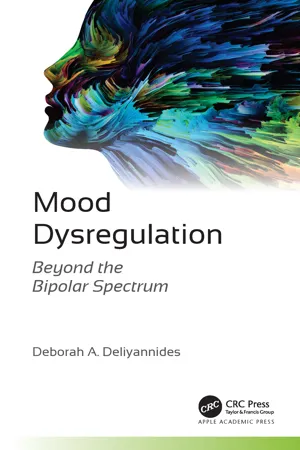
- 318 pages
- English
- ePUB (mobile friendly)
- Available on iOS & Android
About this book
Reflecting the author's vast clinical experience as a psychiatrist, this volume explains why so many people with treatment resistant depression respond to medication used to treat individuals with bipolar disorder. The book also helps to minimize the bipolar stigma by introducing the concept of "mood dysregulation."
At present, people with mood dysregulation are not adequately described on the pages of any diagnostic manual. A cardinal feature of mood dysregulation is dysphoria, a negative mood that is poorly understood but mistaken for the negative mood of depression, creating diagnostic confusion, one of the sources of treatment resistant depression. The author explains that a preponderance of the people she has seen in her practice who have so-called depression have mood disorders with features of bipolar disorder, including response to medications typically effective in people with bipolar disorders. Thus, these people are research orphans: to this day, a paucity of literature exists on this group of individuals. In this volume, the author addresses the clinical problems that result from failure to recognize such mood disorders.
Key features of the book:
- Provides a thorough discussion of dysphoria that is not found in other books on the market
- Proposes a solution to a common and troublesome clinical problem, that of misidentified treatment resistant depression
- Helps to destigmatize the treatments that are most beneficial to those with dysphoria by introducing the concept of "mood dysregulation"
- Discusses the etiology of mood disorders with implications for prevention
This volume aims to help mental health professionals and patients more accurately recognize negative mood symptoms, dysphoria in particular, and arrive at more appropriate interventions to improve treatment outcomes for depression. No other book on the market takes up the topic of dysphoria and how its confusion with depression can lead to diagnostic mistakes that, in turn, lead to treatment failures and so-called treatment resistant depression.
Frequently asked questions
- Essential is ideal for learners and professionals who enjoy exploring a wide range of subjects. Access the Essential Library with 800,000+ trusted titles and best-sellers across business, personal growth, and the humanities. Includes unlimited reading time and Standard Read Aloud voice.
- Complete: Perfect for advanced learners and researchers needing full, unrestricted access. Unlock 1.4M+ books across hundreds of subjects, including academic and specialized titles. The Complete Plan also includes advanced features like Premium Read Aloud and Research Assistant.
Please note we cannot support devices running on iOS 13 and Android 7 or earlier. Learn more about using the app.
Information
Table of contents
- Cover Page
- Half Title page
- Title Page
- Copyright Page
- Dedication
- About the Author
- Acknowledgments
- Contents
- Preface
- Introduction
- 1 Historical Background
- 2 DSM Mood Disorders
- 3 Diagnostic Systems
- 4 Mood Dysregulation
- 5 Co-Occurring/Related Conditions
- 6 Biology
- 7 Etiology
- 8 Treatment
- 9 Clinical Illustrations
- Epilogue
- Appendix A: Abbreviations
- Appendix B: Clinical Data
- Appendix C: Diagnostic Criteria
- References
- Index